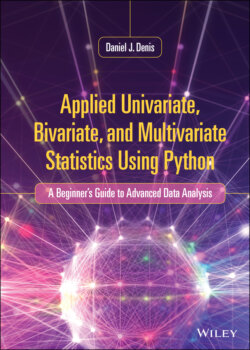Читать книгу Applied Univariate, Bivariate, and Multivariate Statistics Using Python - Daniel J. Denis - Страница 16
1.2 Statistics and Decision-Making
ОглавлениеWe have discussed thus far that a null hypothesis is typically rejected when the probability of observed data in the sample is relatively small under the posited null. For instance, with a simple example of 100 flips of a presumably fair coin, we would for certain reject the null hypothesis of fairness if we observed, for example, 98 heads. That is, the probability of observing 98 heads on 100 flips of a fair coin is very small. However, when we reject the null, we could be wrong. That is, rejecting fairness could be a mistake. Now, there is a very important distinction to make here. Rejecting the null hypothesis itself in this situation is likely to be a good decision. We have every reason to reject it based on the number of heads out of 100 flips. Obtaining 98 heads is more than enough statistical evidence in the sample to reject the null. However, as mentioned, a rejection of the null hypothesis does not necessarily mean the null hypothesis is false. All we have done is reject it. In other words, it is entirely possible that the coin is fair, but we simply observed an unlikely result. This is the problem with statistical inference, and that is, there is always a chance of being wrong in our decision to reject a null hypothesis and infer an alternative. That does not mean the rejection itself was wrong. It means simply that our decision may not turn out to be in our favor. In other words, we may not get a “lucky outcome.” We have to live with that risk of being wrong if we are to make virtually any decisions (such as leaving the house and crossing the street or going shopping during a pandemic).
The above is an extremely important distinction and cannot be emphasized enough. Many times, researchers (and others, especially media) evaluate decisions based not on the logic that went into them, but rather on outcomes. This is a philosophically faulty way of assessing the goodness of a decision, however. The goodness of the decision should be based on whether it was made based on solid and efficient decision-making principles that a rational agent would make under similar circumstances, not whether the outcome happened to accord with what we hoped to see. Again, sometimes we experience lucky outcomes, sometimes we do not, even when our decision-making criteria is “spot on” in both cases. This is what the art of decision-making is all about. The following are some examples of popular decision-making events and the actual outcome of the given decision:
The Iraq war beginning in 2003. Politics aside, a motivator for invasion was presumably whether or not Saddam Hussein possessed weapons of mass destruction. We know now that he apparently did not, and hence many have argued that the invasion and subsequent war was a mistake. However, without a proper decision analysis of the risks and probabilities beforehand, the quality of the decision should not be based on the lucky or unlucky outcome. For instance, if as assessed by experts in the area the probability of finding weapons of mass destruction (and that they would be used) were equal to 0.99, then the logic of the decision to go to war may have been a good one. The outcome of not finding such weapons, in the sense we are discussing, was simply an “unlucky” outcome. The decision, however, may have been correct. However, if the decision analysis revealed a low probability of having such weapons or whether they would be used, then regardless of the outcome, the actual decision would have been a poor one.
The decision in 2020 to essentially shut down the US economy in the month of March due to the spread of COVID-19. Was it a good decision? The decision should not be evaluated based on the outcome of the spread or the degree to which it affected people’s lives. The decision should be evaluated on the principles and logic that went into the decision beforehand. Whether a lucky outcome or not was achieved is a different process to the actual decision that was made. Likewise, the decision to purchase a stock then lose all of one’s investment cannot be based on the outcome of oil dropping to negative numbers during the pandemic. It must be instead evaluated on the decision-making criteria that went into the decision. You may have purchased a great stock prior to the pandemic, but got an extremely unlucky and improbable outcome when the oil crash hit.
The launch of SpaceX in May of 2020, returning Americans to space. On the day of the launch, there was a slight chance of lightning in the area, but the risk was low enough to go ahead with the launch. Had lightning occurred and it adversely affected the mission, it would not have somehow meant a poor decision was made. What it would have indicated above all else is that an unlucky outcome occurred. There is always a measure of risk tolerance in any event such as this. The goal in decision-making is generally to calibrate such risk and minimize it to an acceptable and sufficient degree.
